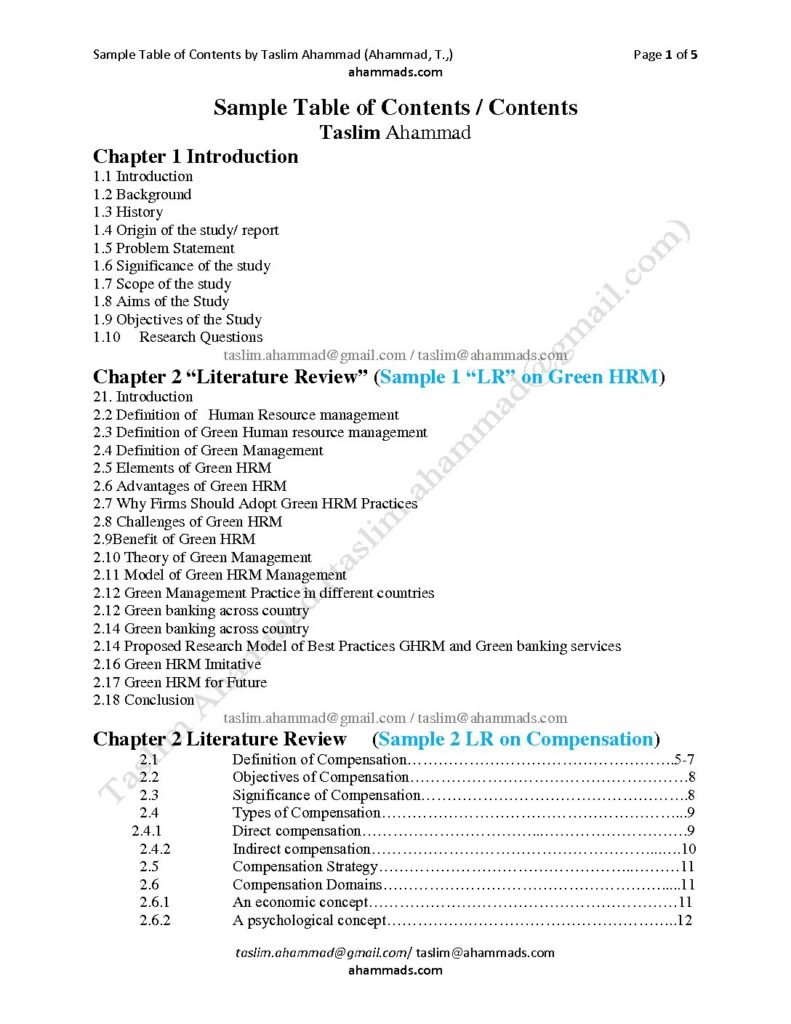Sample Table of Contents / Contents
Taslim Ahammad
Chapter 1 Introduction
- Introduction
- Background
- History
- Origin of the study/ report
- Problem Statement
- Significance of the study
- Scope of the study
- Aims of the Study
- Objectives of the Study
- Research Questions
taslim.ahammad@gmail.com / taslim@ahammads.com
Chapter 2 “Literature Review” (Sample 1 “LR” on Green HRM)
- Introduction
2.2 Definition of Human Resource management
2.3 Definition of Green Human resource management
2.4 Definition of Green Management
2.5 Elements of Green HRM
2.6 Advantages of Green HRM
2.7 Why Firms Should Adopt Green HRM Practices
2.8 Challenges of Green HRM
2.9Benefit of Green HRM
2.10 Theory of Green Management
2.11 Model of Green HRM Management
2.12 Green Management Practice in different countries
2.12 Green banking across country
2.14 Green banking across country
2.14 Proposed Research Model of Best Practices GHRM and Green banking services
2.16 Green HRM Imitative
2.17 Green HRM for Future
2.18 Conclusion
taslim.ahammad@gmail.com / taslim@ahammads.com
Chapter 2 Literature Review (Sample 2 LR on Compensation)
2.1 Definition of Compensation…………………………………………….5-7
2.2 Objectives of Compensation………………………………………………8
2.3 Significance of Compensation…………………………………………….8
2.4 Types of Compensation……………………………………………………9
2.4.1 Direct compensation……………………………………………………….9
2.4.2 Indirect compensation…………………………………………………….10
2.5 Compensation Strategy…………………………………………..………11
2.6 Compensation Domains…………………………………………………..11
2.6.1 An economic concept……………………………………………………11
2.6.2 A psychological concept…………….…………………………………..12
2.6.3 A sociological concept….………………………………………………12
2.6.4 A political concept………………………………………………………13
2.6.5 An equity concept………………………………………………………13
2.6.6 A multidiscipline concept………………………………………………14
2.7 Requirements of Compensation Management…………………………..14
2.8 Compensation Management Plans……………………………………14-17
2.9 Different Theories for Managing Compensation………………………..17
2.10 Determinants of compensation……………………………….………18-22
2.11 Compensation planning and control…………………………………….22
2.12 International compensation and relocation………………………………22
2.13 Compensation Management Practices in Different Countries……….23-25
2.14 Compensation Management System of Bangladeshi Banking Sector…..25
2.15 Pay structure of Bangladeshi Banking Sectors………………………….26
2.15.1 Agrani Bank Limited……………………………………………………26
2.15.2 Salary Statement of Agrani Bank Employees…………………………..27
2.15.3 Types of Compensation Management of ABL…………………………28
2.16 Principles of the Compensation Management of Agrani Bank…………30
2.17 Compensations, Rewards and Benefits…………………………………31
2.18 Compensation, pay and benefit on Jamuna Bank……………………32-38
` 2.19 Researchers Opinion…………………………………………………39-41
2.20 Conclusion
| taslim.ahammad@gmail.com / taslim@ahammads.com
Chapter 2 Literature Review (Sample 3 “LR” on Recruitment and Selection) |
||
| 2.1 Introduction | ||
| 2.2 The concept of recruitment and selection | ||
| 2.3 Definitions of recruitment | ||
| 2.4 Sources of recruitment | ||
| 2.5 Internal Sources of recruitment | ||
| 2.6 External Sources of recruitment | ||
| 2.7 Definition of selection | ||
| 2.8 Selection process | ||
| 2.9 Screening | ||
| 2.10 Selection tests | ||
| 2.11 Reference & background check | ||
| 2.12 Interview | ||
| 2.13 Physical examination | ||
| 2.14 Job offer | ||
| 2.15 Recruitment and selection models | ||
| 2.16 Recruitment & selection practices in Bangladesh | ||
| 2.17 Recruitment and selection practices in United Kingdom | ||
| 2.18 Recruitment and selection practices in Japan | ||
| 2.19 Improving the effectiveness of recruitment and selection | ||
| 2.20 Ethical issues in recruitment and selection | ||
| 2.21 Conceptual framework | ||
| 2.22Conclusion | ||
Chapter 2 Literature Review (Sample 4 “LR” on Health and Safety)
2.1 Definition
2.2 Causes of Health and Safety
2.3 Dimension of Health and Safety
2.4 The nature and scope of Health and Safety
2.5 The importance of Health and Safety
2.6 Factors of Health and Safety
2.7 Theory of Health and Safety
2.8 Method of Health and Safety
2.9 Model of Health and Safety
2.10 Core components of employee Health and Safety within organization
2.11 Health and Safety characteristics
2.16 Health and Safety practice of Bangladesh in garment sector
2.17 Conclusion
taslim.ahammad@gmail.com /taslim@ahammads.com
Chapter 3 Methodology (Sample 1 “M”)
3.1 Definition of Mythology
3.2 Primary and Secondary
Mix methods
3.3 Qualitative, Quantitative and Mixed Method
3.4 Focus Group
3.5 Observation
3.6 Ethical issues
3.7 Methodology of the study
3.8Source of data
3.9 Questioner
3.10 Data sources
3.11 Data collection methods
3.12 Research approach
3.13 Research design
taslim.ahammad@gmail.com / taslim@ahammads.com
Chapter 3 Methodology (Sample 2 “M”)
3.1 Introduction
3.2 Methodology
3.3 Research Design
3.4 Sampling Design
3.5 Sampling Frame
3.6 Research Procedures
3.7 Data Analysis Methods
3.8 Qualitative
3.9 Quantitative
3.10 Mix Method
3.11 Primary Data
3.12 Secondary Data
3.13 Observation
3.14 Questionnaire
3.15 Research Ethics
taslim.ahammad@gmail.com / taslim@ahammads.com
| Chapter 3 Methodology (Sample 3 “M”) | |
| 3.1 Introduction | |
| 3.2 Research methodology | |
| 3.3 Research strategy | |
| 3.4 Research Design | |
| 3.5 Quantitative method | |
| 3.6 Qualitative method | |
| 3.7 Mix method | |
| 3.8 Sources of data | |
| 3.9 Primary data | |
| 3.10 Secondary data | |
| 3.11 Population | |
| 3.12 Data collection | |
| 3.13 Data analysis | |
| 3.14 Conclusion | |
taslim.ahammad@gmail.com / taslim@ahammads.com
Chapter 4 Findings (F Sample 1)
4.1 Introduction
4.2 Finding1
4.3 Finding 2
4.15…….Finding 14
4.16 Discussion
4.17 Conclusion
| Chapter 4 Findings and Discussion (“F&D” Sample 2) | |
| 4.1 Introduction | |
| 4.2 Formal policy on recruitment and selection | |
| 4.3 Recruitment and selection methods by construction industry | |
| 4.4 Challenges recruitment and selection of workers | |
| 4.5 Recruitment and Selection influence workers’ performance | |
| 4.6 Questionnaire respondent rates | |
| 4.7 Experience of respondents | |
| 4.8 Professional qualification of respondents | |
| 4.9 Formal policy for the recruitment and selection of employees | |
| 4.10 Recruitment and selection methods | |
| 4.11 Highly ranked recruitment and selection method | |
| 4.12 Recruitment and selection effect on employees performance | |
| 4.13 Factors to improve recruitment and selection practices | |
| 4.14 Conclusion | |
taslim.ahammad@gmail.com / taslim@ahammads.com
Chapter 5 Conclusion and Recommendations
taslim.ahammad@gmail.com / taslim@ahammads.com
Limitations
Appendixes:
Appendix 1 References
Appendix 2 Questioner
Appendix 3 Chart 1
Appendix 3 Extra / so on
